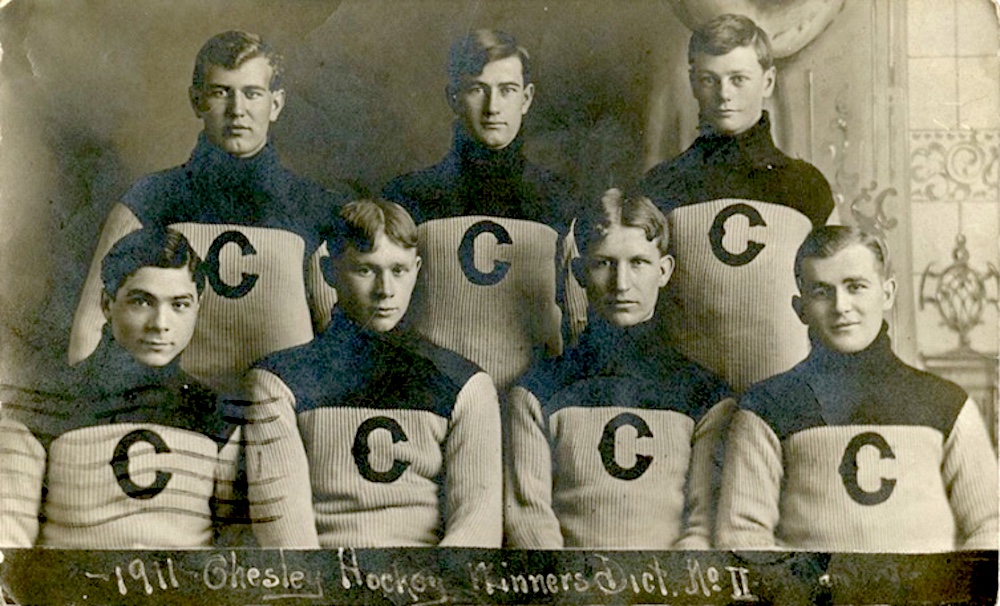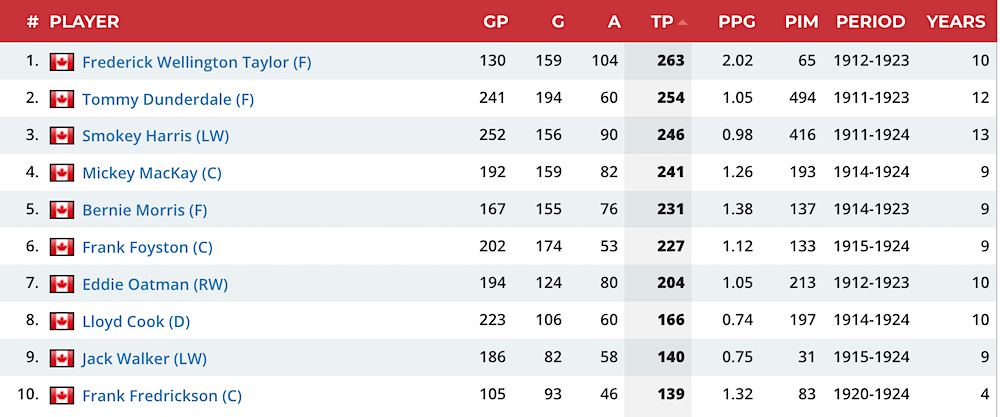This week, as Owen Sounders take part in Hockey Day in Canada festivities prior to Saturday’s day-long broadcast from here in The Scenic City, as least one current Own Sound resident is also noting the anniversary (albeit the somewhat inelegant 116th) of another small-town hockey story: the Stanley Cup championship of the Kenora Thistles. On this day in 1907, the Thistles were resting up from the first game in their best-of-three series with the Montreal Wanderers — a 4-2 victory on January 17 — and preparing for the second game, which resulted in an 8-6 victory and series sweep on January 21.
This victory, of course, is the centerpiece of my book, Engraved in History: The Story of the Stanley Cup champion Kenora Thistles. Hopefully, some of you received the book at the holidays last month; or had a copy already. (If you didn’t, or don’t, they’re still for sale at Amazon in Canada or at Rat Portage Press. Get yours today!)

In many of the interviews I’ve done to promote the book, people asked about doing the research for a story that’s so old. Yes, it took a lot of work, but, in some ways, it was very easy. It mainly involved reading and reading through many, many old newspapers … which is one of my favourite ways to pass the time anyway.
During these days of the decline and fall of print media, it can be hard to imagine just how many newspapers there used to be. Any town of almost any size was likely to have, if not its own daily paper, at least a weekly or a biweekly (as Rat Portage/Kenora did). And in bigger cities, there were many, many different dailies competing for readers.

In newspapers of only 10 to 12 pages, with perhaps only a single page of sports news, the coverage was still be quite in depth. Especially if you were a Stanley Cup contender boasting some of the greatest players in the game — even if your team hailed from a town of only about 6,000 people. So many rumors of player movements in or out of Kenora were reported year-round in the early 1900s all across Canada. Multiply that by all the other hockey teams playing in communities across the country and even the “insiders” reporting on television today would be hard-pressed to keep up. As Stanley Cup games approached, coverage only intensified.
As I’ve written in these “pages” several times before (How They Watched…, Hello Out There…, and Tuning in Over Time), the earliest telegraphed reports of Stanley Cup games being sent out to crowds of listeners date back to 1896. Not too long after that, newspapers reporting on games the following day would provide those telegraphed play-by-play accounts for their readers. They are remarkably detailed and modern. Consider this from the pregame leading up the January 17 Thistles-Wanderers game from the Winnipeg Tribune of January 18, 1907:

- 8.20 p.m.—The rink is filling up rapidly and the prospects are for an immense crowd in spite of the extreme cold. The 50 cent seat crowd are smoking in spite of the prohibitory notice against the practice. The [Thistles] are favorites in the betting at about 100 to 80. The general opinion is favorable to Kenora for tonight’s game.
- 8.25—Reserved seats are now filling rapidly. The crowd is going to be a tremendous one. The [Thistles] are now in the dressing room getting the preliminary rub-down.
- 8.35—Wanderers are out on the ice for warming up. They look in good shape, except for [Moose] Johnson, who wears a souvenir of the game with Ottawa. Ernie Russell changed his mind at the last moment and is in uniform. It had been said during the day that he would not be out.
- 8.37—The [Thistles] are out on the ice. They got a tremendous ovation. Their skating is taking immensely with the crowd in spite of Wanderer sympathies. [Kenora captain Tommy] Phillips seems to be up to his old-time gait….
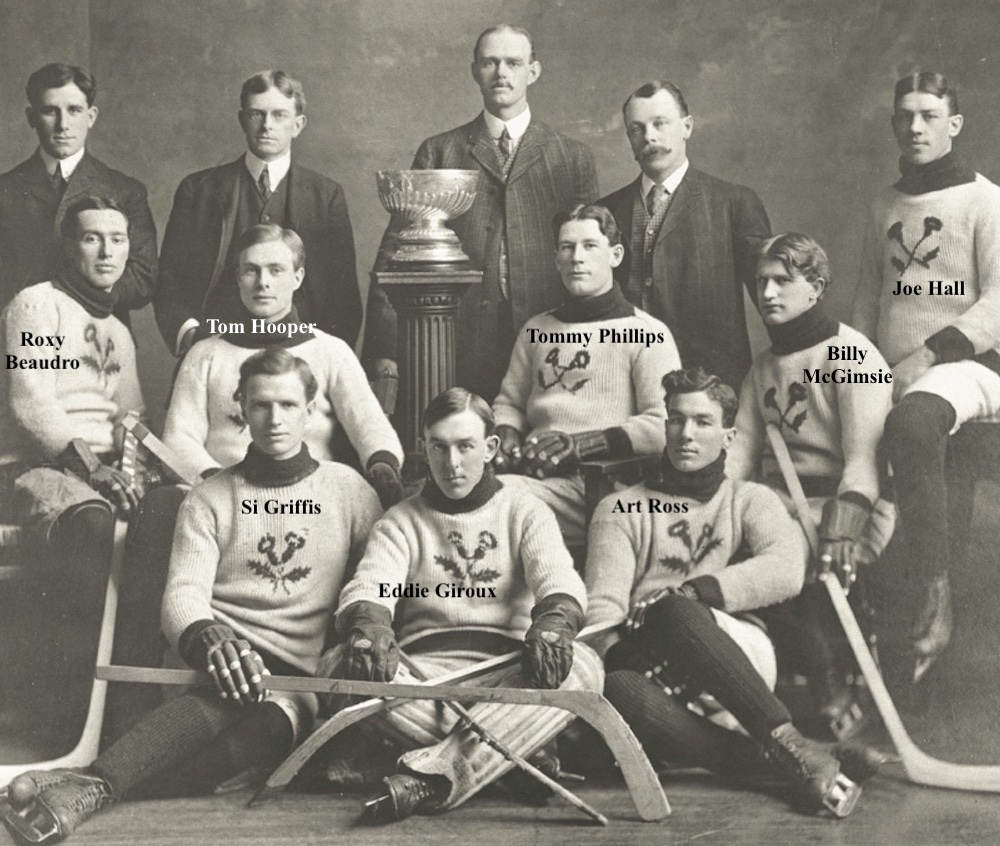
- 8.45—Both teams are warming up waiting for referee. There are very few empty seats, and those only in the reserved section. About 5,000 people now in the rink and a steady stream of humanity floating in. Players are now shaking hands at the side. Phillips wears a broad confident smile. [The Wanderers’ Lester] Patrick is looking businesslike.
- 8:53— [Referee Bob] Meldrum calls teams to centre of ice. Now tossing for ends. Getting final instructions from referee. Crowd wild with excitement. Wanderers win toss and defend southern goal. A horseshoe with Wanderers colors covering it is just thrown on the ice.
- 8.55—They’re off!
As to the extreme cold referenced in the first notice, I discovered the Government of Canada has a website with historic weather data. Through that site, I was able to confirm the newspaper reports that not only was it freezing cold in Montreal on January 17 with a low of -31° Celsius (24 below zero Fahrenheit), but that it really did warm up so much in the next couple of days (as newspapers also reported) that it actually rained on January 19 and 20 before plunging well below freezing again on January 21.
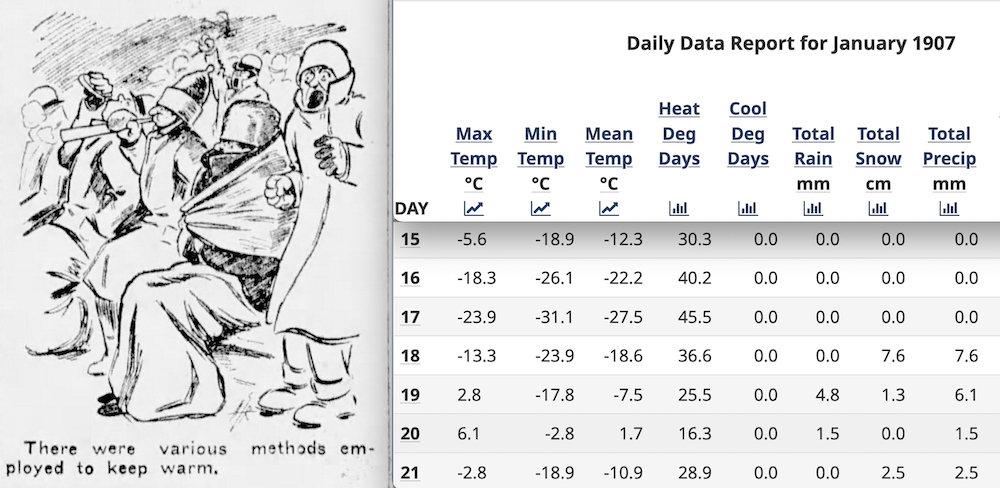
Up in Kenora, the temperature that night, according to the historical data, ranged from a high of about -23° Celsius (about 10 below Fahrenheit) to a low of -37 (35 below). The Victoria rink, where Thistles fans gathered to hear the telegraphed reports read out, was only heated by wood-burning stoves in the two dressing rooms, but it seemed to have been warm enough inside. In its local recap of the game, the Kenora Miner and News reported that the scene inside rink had been “enlivening to the limit,” particularly as the Thistles build up a 6-2 lead that night. But things got tense (in Kenora and in Montreal) as the Wanderers fought back to tie the game 6-6 with only a few minutes remaining before the Thistles won the Cup.
With all the reading of old newspapers I did, I came across a story in the Winnipeg Telegram from March 20, 1907, telling about those final minutes on January 21, 1907, that I’d never heard before. The teller of the tale was Mike Shea, one of the referees in game two.
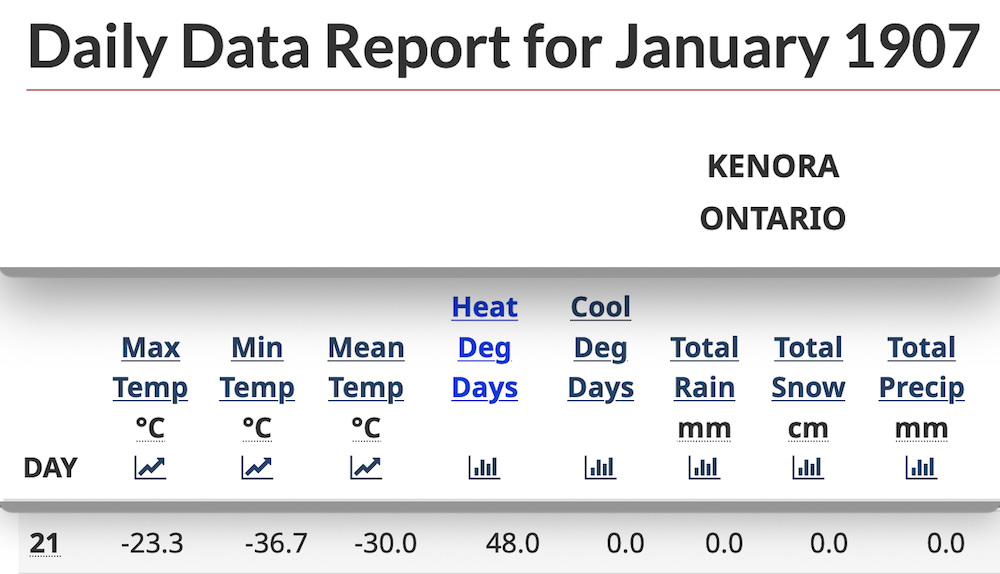
“You can talk as you like about peculiar circumstances under which big games have been decided,” said Shea, “but I want to tell you that the Stanley Cup was once lost as the result of a torn pair of pants. And it occurred just two months ago when Kenora beat the Wanderers in the final game of the series.”
Shea sets the scene, reminding readers that the Thistles had jumped out to a big lead before the Wanderers roared back to tie the game. “It was a fine rally,” said Shea, “and the tide switched right around…. The Thistles, to a man, were all skated out; they looked beaten and in fact were beaten had not the incident on which this story hinges cropped up…. Wanderers were there with a bundle of speed and I expected them to turn in and utterly rout Phillips and his men.
“Away went the forwards and I started after them when [Jack] Marshall skated up to me and shouted: ‘Mike, blow your whistle!’
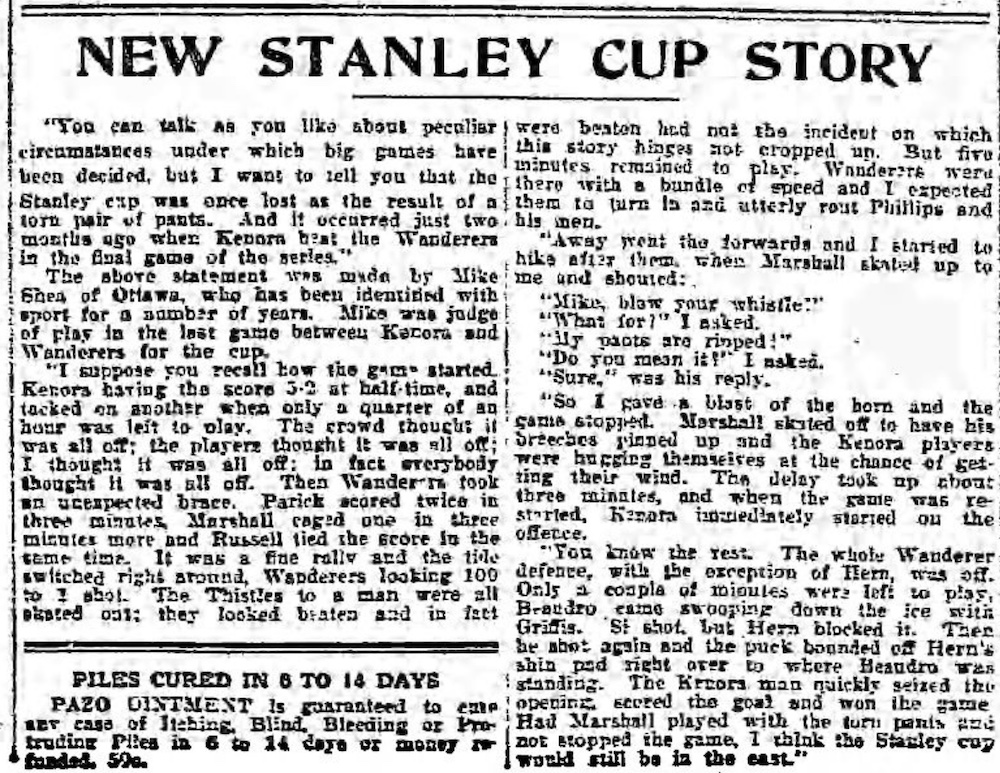
“‘What for?’ I asked.
“‘My pants are ripped!’
“‘Do you mean it?’ I asked.
“‘Sure,’ was his reply.
“…I gave a blast of the horn and the game stopped. Marshall skated off to have his breeches pinned up and the Kenora players were hugging themselves at the chance of getting their wind. The delay took about three minutes, and when the game was restarted, Kenora immediately starred on the offence.
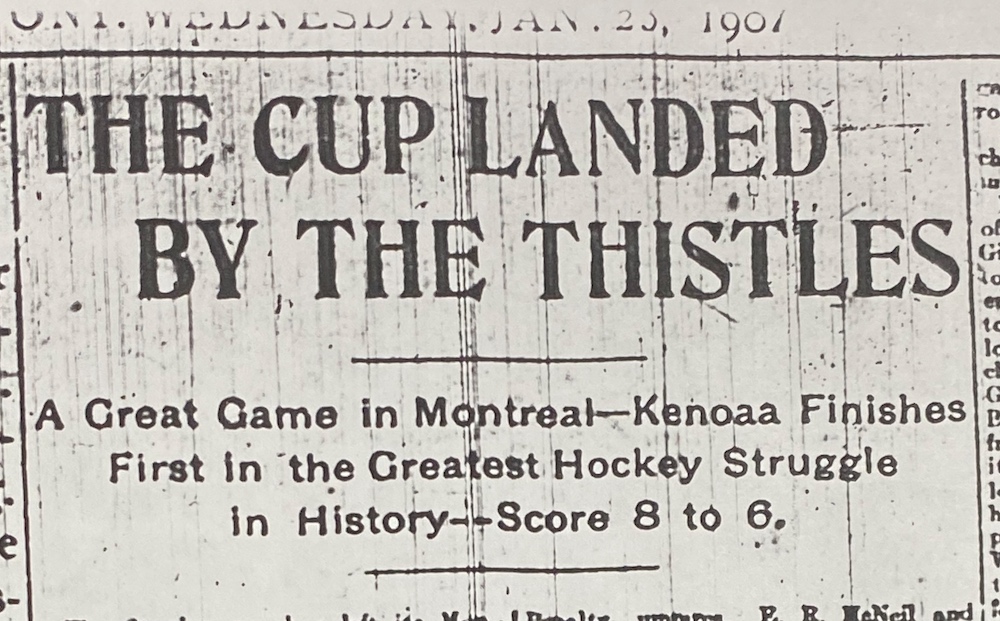
“You know the rest,” said Shea, describing the late penalties to Montreal’s Hod Stuart and Lester Patrick and the goal that Roxy Beaudro scored to reclaim the lead for the Thistles, but: “Had Marshall played with the torn pants and not stopped the game, I think the Stanley Cup would still be in the east.”
So, there you go.
The Kenora Thistles might just owe their Stanley Cup victory to a pair of torn pants … 116 years ago this Saturday.
* * * * * * * * * * * *Hockey Writers in Canada
A reminder that, in conjunction with Hockey Day in Canada, I’ll be taking part in Hockey Writing in Canada via Zoom with Owen Sound-born author and historian Paul White through the Owen Sound library tomorrow (Friday, January 20) at 3pm ET. You can contact the library for the zoom link at info@library.osngupl.ca or email me at eric@ericzweig.com and ask me for it.
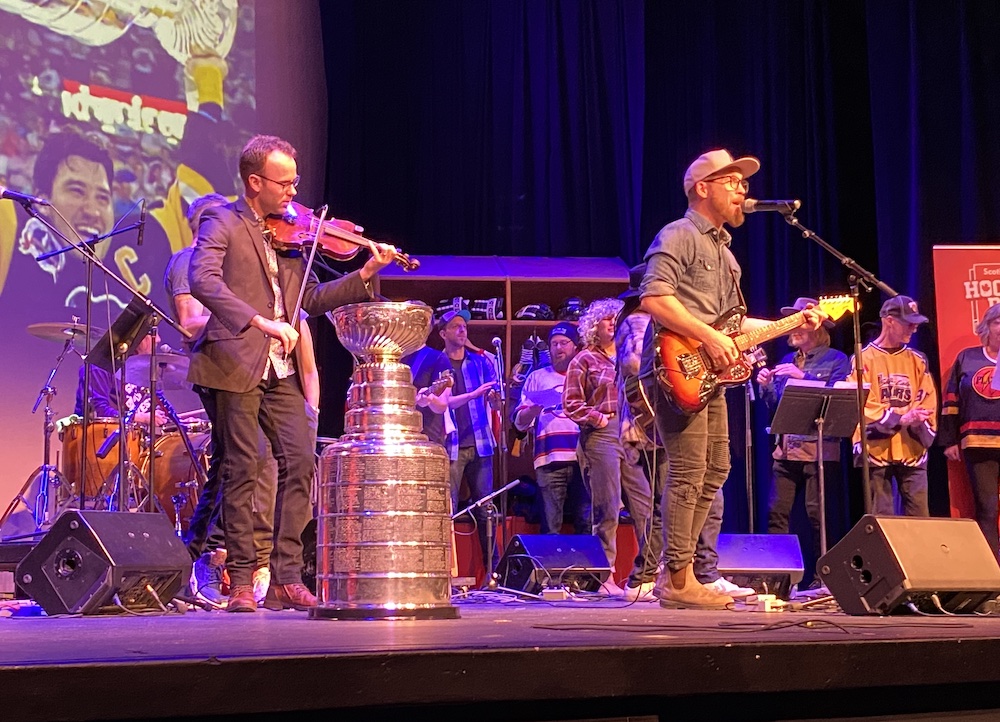
Hockey Day in Canada concert at the Roxy Theatre in Owen Sound was a big hit!

